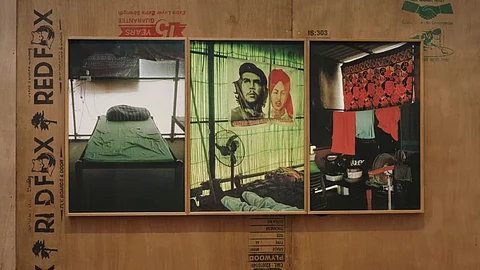
- HOMEGROWN WORLD
- #HGCREATORS
- #HGEXPLORE
- #HGVOICES
- #HGSHOP
- CAREERS
- ABOUT US
- CONTACT US

The Delhi Farmers' Protest of 2021 was one of the largest mass agitation movements to take place in India in recent decades. The year-long protest against three proposed agriculture laws saw tens of thousands of farmers from Punjab, Haryana, and Uttar Pradesh camp on Delhi's borders for over a year from late 2020 to late 2021. The farmers feared that these laws would dismantle the existing Minimum Support Price (MSP) system, leave them vulnerable to exploitation by large corporations, and erode the traditional mandi system, which provided them with a safety net.
In protest against these proposed farm laws, the farmers set up camps at the Singhu, Tikri, and Ghazipur border-crossing points of Delhi. They remained on the roads leading into New Delhi through the COVID-19 pandemic and the extremes of the North Indian climate — including the freezing winter, searing heatwaves, and a dengue festering monsoon — transforming the farming vehicles that they arrived on, such as tractors, trolleys, and tempos, into temporary makeshift homes. These camps became semi-permanent settlements. The protest sites became hubs of cultural expression — with music, poetry, and art playing a central role in raising awareness about farmers' issues and sustaining morale against government pushback.
As the protest raged on, Prix Pictet award-winning photographer Gauri Gill visited the protest sites and photographed what she called "an unusual, handmade and homegrown architecture of resistance, in which doors appeared through tarpaulin, and walls arose from bamboo". Using a large-format analogue camera, Gill focused on the domestic and utilitarian aspects of the protest sites, capturing the farmers' ability to adapt and sustain themselves. The highway itself became a site of cultivation, with patches of earth used to grow vegetables. The farmers' actions were guided by Sikh principles of langar (communal food sharing) and seva (service), the farmers fed not only themselves but also the local communities as well as the police personnel who stopped them from entering the capital with concrete barricades, tear gas, and water cannons.
Gill's photographs — on view at Vadehra Art Gallery in Delhi as part of a solo exhibition titled 'The Village on the Highway' till March 4, 2025 — emphasise the temporal and ephemeral nature of the protest, showcasing the farmers' dignified tenacity and their ability to adapt in the face of seemingly insurmountable odds. By incorporating materials from the protest sites into the exhibition, Gill further grounds the viewer in the physical reality of the farmers' struggle, underscoring the urgency and inventiveness of their resistance. In this way, the body of work becomes a testament to the farmers' enduring spirit and is a continuation of Gill's broader practice of documenting marginalised communities and "how people in precarity find ways to float, rather than drown".
'The Village on the Highway' by Gauri Gill is on view at Vadehra Art Gallery, D-40 Defence Colony, New Delhi, till March 4, 2025.
